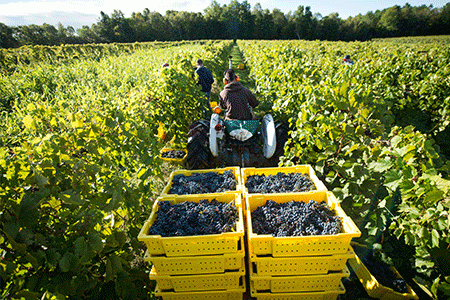Organic dairy farmers ask for a $9.2 million helping hand to combat growing trends
Photo courtesy of the Vermont Department of Agriculture
Eleven organic dairy farms in Vermont closed in 2021. The next year, 18 more followed. And this year the Northeast Organic Farming Association of Vermont expects to lose another 28 farms.
That data — compiled by a state dairy task force and described to legislators recently — is why the association wants to see $9.2 million sent to organic dairy farmers in this year’s budget.
Association leaders asked legislators for the one-time payment during a joint meeting of the House and Senate agriculture committees last Thursday. That total would compensate organic farmers for losses they have experienced because of fluctuating dairy prices — which, the association says, have grown only more chaotic in recent years.
The $9.2 million sum would be the equivalent of $5 per hundredweight payment for all organic producers’ production in 2022. Hundredweight is a measurement used in dairy markets that equals 100 pounds of milk.
Those testifying in support of the request did not specify at the hearing how the money would be distributed.
Over the past few years, many of Vermont’s organic dairy farms have been forced to close. Farmers have been receiving $8 to 10 per hundredweight below the cost of production, according to the organic farmers association.
Jen Miller, the group’s farm services director, described in an interview how that trend — coupled with rising feed, fuel and labor costs since 2021 — has left many farmers unable to pay their bills or make payments on their loans.
Organic dairy farms started seeing lower payments in 2017, said Miller when speaking to lawmakers. That year farmers saw a decrease of $2 to $3 per hundredweight, Miller said in committee, and prices continued to drop into 2020.
Last year, farmers’ situation was exacerbated by drought, inflation, rising production costs and supply chain issues.
“We're getting to the point where the best managers are not able to squeeze more income or cut their expenses any more than they already have over the past five years,” Miller said in an interview.
Farm managers have tried decreasing herd sizes and increasing how much milk they milk from each cow to lessen the burden of the economic challenges, but they are running out of ways to stay afloat, Miller added.
“The loss of these farms to the state represents an economic loss, but it also represents a loss in terms of a culture, a way of life, and also a huge loss in terms of climate resilience,” said Maddie Kempner, the organic farming association’s policy director, in an interview.
The Vermont Dairy Task Force found that in 2021, when 11 farms closed, the state saw an economic loss of more than $41.5 million. In 2022, another $67.9 million was lost when 18 farms closed.
Along with the $9.2 million requested this session from the state, organic farm advocates want to see federal officials create a version of the U.S. Department of Agriculture’s Dairy Margin Coverage Program for organic dairy farms.
The program allows farmers to sign up for risk management insurance through the government. The government pays farms when the difference between the national price of milk and the average cost of feed falls below a certain level.
The program doesn’t account for organic feed costs and organic milk prices, so when only organic farms are struggling, the program doesn’t provide any support.
Sen. Bobby Starr, D-Essex/Orleans, who chairs the Senate Committee on Agriculture, said in an interview that the situation isn’t an easy one to figure out.
Starr said one idea his committee could look at would be creating a program that would kick in when milk prices dropped below a certain level. When that happens, it would cause processors — companies that buy raw milk to make other products — to pay the difference between the cost of production and the commercial price.
Starr also floated the idea of starting a board made up of farmers, consumers and milk processors to help determine who can pay what during price fluctuations. It would be similar to the Northeast Dairy Compact Commission, which ran from 1997 to 2001. The commission, formed by Congress, allowed New England states to set the price of fluid dairy products such as drinking milk.
“I hear more from farmers about the low price they're being paid,” Starr said, “than from consumers about the high price they’re paying.”








